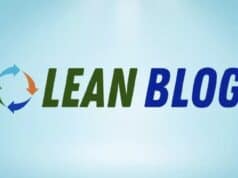By Jason Turgeon:
China's everywhere in the news these days. It seems like you can't open a newspaper (or a feed reader) without reading an article about the summer Olympics, its booming economy, the situation in Tibet, and growing unease over the environmental consequences of China industrializing in the same way the US and Europe did. To capture the moment for us, National Geographic ran an excellent special on the Wenzhou region of China, home to a huge chunk of the world's commodity manufacturing sector. From buttons to bra straps, this is the new home of manufacturing, and as such it should be an area that's of equal interest to both Lean and Green thinkers.
The story follows a family-run manufacturing startup as it tries to break into the lucrative world of manufacturing bra rings (the part you struggled so hard to unclasp in high school) in the city of Lishui. It's simultaneously exhilarating and depressing. On the one hand, there is this spirit of unbridled entrepreneurialism of the sort that made the internet bubble so exciting. On the other hand, in their mad dash to industrialize the entrepreneurs and their complicit government leaders are duplicating many of our worst mistakes. This is not a story of flow, or the elimination of waste, or of respect for land and people. Instead, this is the story of a region that celebrates the best and worst of unregulated capitalism.
The family leases a facility in a brand-new industrial development, built in the least environmentally sensitive conceivable manner on land that's practically stolen from the peasants who are forced to sell it at below-market rates. The facility ramps up production on a commodity that's completely dependent on a machine that only one person really knows how to operate well, a machine that seems engineered to waste energy and a machine which constantly threatens to break down, bringing production to a halt. The same peasants who are no longer farming are now working 50 hour weeks for minimal pay. The factory starts production with no customers, amassing a huge backlog of product while it waits for sales to start up. And then, one day barely a year after it opened, its owners jump to an even newer development, leaving behind nothing but a legacy of waste.
What's so heartbreaking about this story is that Lean and Green both work so much better if they're applied from the start, in the design phase. But time and again, we see this kind of completely unplanned development. The business owners in this story, who don't have much of an education, aren't portrayed as the kind of people who think much past next week, certainly not the kind of people likely to embrace lean concepts or worry about the environment. The government officials pushing the new development along brag about the number of hills they've flattened and wetlands they've filled in the name of this development.
It's not explicitly stated in the story, but the impression is that any concession to forward-thinking practices, to environmental considerations, to an applied thoughtfulness in the way they do business, would be immediately written off as too expensive and impractical. But what's more expensive? Spending your increasingly thin profit margin on wasted energy? Moving your factory multiple times? Coming back in 40 years and trying to undo the environmental damage you've left behind?
I guess the larger question for the readers of this blog is how do you get people like this–business smart entrepreneurs who only understand the bottom line–on board with Lean? And at the same time, how do you convince the local governments that pushing development in a more sustainable manner will attract a better clientele, cost less over the long run, and be better for the citizenry? It seems to me that these are two sides of the same coin. Readers with experience in this kind of rapid-growth situation and/or Chinese manufacturing, please leave your thoughts in the comments.
Subscribe via RSS Lean Blog Main Page Podcast Twitter @MarkGraban
Please scroll down (or click) to post a comment. Connect with me on LinkedIn.
Let’s build a culture of continuous improvement and psychological safety—together. If you're a leader aiming for lasting change (not just more projects), I help organizations:
- Engage people at all levels in sustainable improvement
- Shift from fear of mistakes to learning from them
- Apply Lean thinking in practical, people-centered ways
Interested in coaching or a keynote talk? Let’s talk.
Join me for a Lean Healthcare Accelerator Trip to Japan! Learn More










Unregulated capitalism? Are you serious?
I would be equally interested to follow the travails of the family in South Carolina who lost their jobs in the ‘bra ring’ factory and are probably left amongst the legions of those now made permanently wards of the state by unregulated predatory investment in China.
Hooks and eyes are what get unhooked. Bra rings are used as loops to make the straps adjustable.
However, to the gist of the post, introducing “lean” can be done as thoughlessly as building without thinking about the environment. I found a good example of “improvements” that jeopardized employee safety and summarized them in a post on Lean Reflections – http://leanreflect.blogspot.com/2008/01/first-do-no-harm.html
Great post, couldn’t agree more.
It’s strange though. The “culture” experts always said that the Chinese (and most Asian cultures) had a very long-term orientation towards time and used holistic thinking patterns…
But where are those qualities now when they need it the most?
Once you destroy the land, it’s so hard to get it back. Once a culture gets stuck on the “buy, consume, destroy” mentality, it too is hard to drop.
They had the immense power to leapfrog us and they’re blowing it. The future’s going to be interesting…
I just returned from a 3 week vacation in China and completely agree with the depiction of China’s similarities to the dot com boom times. We were told that the gap between the rich and poor in China today is larger than it ever has been in China’s history. This sort of gap will inevitably cause problems but for now even the poorest are so much better off now than they were 10 or 20 years ago that they still feel positive about their lot in life.
One small correction–I believe that all land in China is owned by the state. People can own buildings, etc. but the government owns the land. This is one reason that construction projects can be completed so quickly.
Comments are closed.